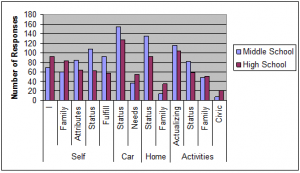Caroline Crane and Dr. Ivan Beutler, Home and Family Living
Money attitudes may help us better understand potential vulnerabilities of youth in a growing culture of materialism. Today’s American child is immersed in the consumer marketplace to a degree that dwarfs all other historical experience (Schor, 2004). For many teens success revolves around financial status, social recognition, or appealing appearance (Roberts and Jones, 2001). Extrinsically focused individuals frequently depend on financial resources to achieve the favorable reactions of others in defining themselves. Modern industrialized society has transformed adolescence from a developmental era defined by production to one mainly of consumption where earning and spending money has become one of the most prominent features of the period (Steinberg and Cauffman, 1995).
However, there is evidence that this materialism leads to a less satisfying life compared to an intrinsic emphasis on affiliation (relatedness), building community (helpfulness), physical fitness (health), and self-acceptance (growth) (Kasser & Ryan, 1996). A notable developmental change of late adolescence is a diminishing amount of social comparison as one’s own ideals are established (Harter, 2001). Dr. Ivan Beutler and his staff are involved in a research project in the BYU Family Studies Research Center under the project name Spending Well. This larger project examines the extent to which the Spending Well curriculum helps high school students make progress from using money to live high towards using it to live well. As part of the project, Kasser and Ryan’s (1993) Aspiration Index is used to measure the progress a students makes from participating in the Spending Well curriculum. The Aspiration Index provides a quantitative measure that can indicate the extent to which the desired progress is or is not made.
To evaluate the validity of the Aspiration Index responses from 184 Utah high school students were compared to responses from 187 Utah middle school students. Respondents were asked to envision themselves in the future “living well” and to describe what they saw in terms of themselves, and their car, home, and activities. Their answers were coded and evaluated using Grounded Theory Methodology (LaRossa, 2005).
My main responsibility on the project was evaluating the pre and post survey responses from the middle and high school students. The Aspiration Index has two categories, which are intrinsic and extrinsic. Concepts that were categorized as intrinsic: self family, self fulfill, car needs, home family, activities actualizing, activities family, and activities civic. Concepts that were categorized as extrinsic: self “I”, self personal attributes, self status, car status, home status, and activities status.
The main goal of my research was to find out if the Aspiration Index can be used for middle and high school student responses. At this point in time the validity is not conclusive. However, my project was still able to make a valuable contribution to the research team.
As I coded and then charted the student responses, we were able to see that there is development between middle (Fig. 1) and high school students (Fig. 2). While the high school students are still highly extrinsic, they described themselves less often in terms of fame, status, money & physical attributes. This does demonstrate a natural growth maturation. Many of the high school students’ responses reflect personal beliefs, values, and moral standards that have become internalized or constructed from their own experiences.
My experience as a member of the Spending Well research team was excellent. My mentoring experience with Dr. Beutler changed the course of my education. His guidance has helped me truly make the most of my undergraduate education. I recently graduated and am planning on going to graduate school next year. Both the research and teamwork skills that I gained will be invaluable to me as I pursue the next level of education. Additionally, working on this research project has helped me determine what I want to study in graduate school.
Figure 1—This chart compares the responses of the Middle and High School students. Concepts that were categorized as intrinsic: self family, self fulfill, car needs, home family, activities actualizing, activities family, and activities civic. Concepts that were categorized as extrinsic: self “I”, self personal attributes, self status, car status, home status, and activities status.

